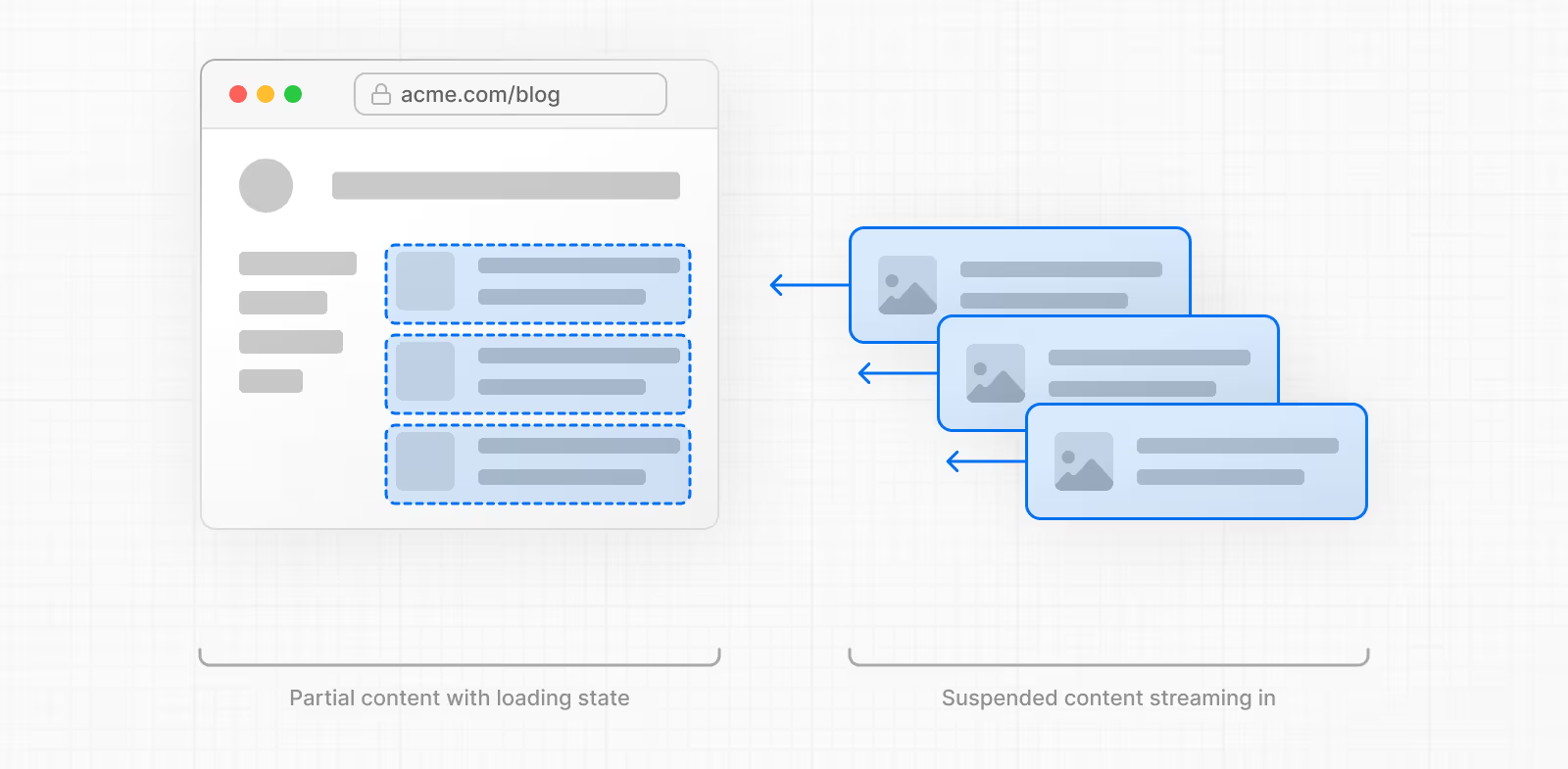[NextJS] Suspense 사용하기
Suspense
<Suspense>는 자식 요소를 로드하기 전까지 화면에 대체 UI(Fallback)를 보여주는 React의 기능이다.
1
2
3
<Suspense fallback={<Loading />}>
<Albums />
</Suspense>
Suspense는 children에 필요한 모든 코드와 데이터를 로딩할 때까지 loading fallback을 보여준다.
Suspense는 아래 데이터에 대해서만 활성화된다.
- Relay와 Next.js 같이 Suspense가 가능한 프레임워크를 사용한 데이터 가져오기
lazy를 활용한 지연 로딩 컴포넌트use를 사용해서 캐시된 Promise 값 읽기
1
2
3
4
5
6
7
8
9
10
11
12
13
14
15
16
// lazy를 활용한 지연 로딩 컴포넌트
import { Suspense, lazy } from "react";
const Chart = lazy(() => import("./Chart"));
export default function Analytics() {
return (
<div>
<h1>분석</h1>
<Suspense fallback={<div>차트 로딩 중...</div>}>
<Chart />
</Suspense>
</div>
);
}
1
2
3
4
5
6
7
8
9
10
11
12
13
14
15
16
17
18
19
20
21
22
23
24
// use를 사용해서 캐시된 Promise 값 읽기
export default function Albums({ artistId }) {
const albums = use(fetchData(`/${artistId}/albums`));
return (
<ul>
{albums.map(album => (
<li key={album.id}>
{album.title} ({album.year})
</li>
))}
</ul>
);
}
export default function ArtistPage({ artist }) {
return (
<>
<h1>{artist.name}</h1>
<Suspense fallback={<Loading />}>
<Albums artistId={artist.id} />
</Suspense>
</>
);
}
또한 Effect 또는 이벤트 핸들러 내부에서 가져오는 데이터는 감지하지 않는다.
Suspense는 컴포넌트가 렌더링 중에 Promise를 throw 할 때만 이를 감지하여 fallback UI를 보여주는데, useEffect는 컴포넌트의 렌더링이 끝난 후 실행되기 때문에 Suspense는 이 상황을 감지할 수 없다.
1
2
3
4
5
6
7
8
9
10
11
12
13
14
15
16
console.log("1. 컴포넌트 함수 실행 시작");
function Component() {
console.log("2. 렌더링 단계");
const [data, setData] = useState(null);
useEffect(() => {
console.log("4. 이펙트 실행 (렌더링 완료 후)");
// 이 시점에는 이미 Suspense 판단이 끝남
fetchData().then(setData);
}, []);
console.log("3. JSX 반환");
return <div>{data || "로딩..."}</div>;
}
Next.js에서의 Suspense 사용
Next.js의 App Router에서 Suspense는 동적 경계를 표시하는 데 사용된다.
1
2
3
4
5
6
7
8
9
10
11
12
13
14
15
16
17
import { Suspense } from "react";
import StaticComponent from "./StaticComponent";
import DynamicComponent from "./DynamicComponent";
import Fallback from "./Fallback";
export const experimental_ppr = true;
export default function Page() {
return (
<>
<StaticComponent />
<Suspense fallback={<Fallback />}>
<DynamicComponent />
</Suspense>
</>
);
}
Next.js는 빌드 시 StaticComponent와 fallback UI를 미리 렌더링하고, Suspense 안의 DynamicComponent는 사용자가 해당 페이지에 접근할 때 스트리밍된다.
스트리밍은 경로를 여러 개의 청크로 분할하고, 준비되는 대로 클라이언트에 점진적으로 스트리밍한다.
이를 통해 사용자는 전체 콘텐츠의 렌더링이 완료되기 전에 페이지의 일부를 즉시 볼 수 있다.
위에서 Suspense의 예제는 React에서 lazy나 use를 사용한 것이었다.
Next.js의 App Router에서는 Suspense의 children이 비동기 서버 컴포넌트인 경우에도 Suspense가 활성화된다.
1
2
3
4
5
6
7
8
9
10
11
12
13
14
15
16
17
18
19
20
21
22
23
24
25
26
27
import { Suspense } from "react";
// 서버 컴포넌트
async function UserList() {
const users = await fetch("https://jsonplaceholder.typicode.com/users").then(
(res) => res.json()
);
return (
<ul>
{users.map((user) => (
<li key={user.id}>{user.name}</li>
))}
</ul>
);
}
export default function UsersPage() {
return (
<div>
<h1>사용자 목록</h1>
<Suspense fallback={<div>사용자 정보 로딩 중...</div>}>
<UserList />
</Suspense>
</div>
);
}
클라이언트 컴포넌트에서 Suspense를 활성화하려면 서버 컴포넌트로부터 Promise 데이터를 prop으로 전달받아 use 훅으로 감싸면 된다.
1
2
3
4
5
6
7
8
9
10
11
12
13
14
15
16
17
18
19
20
21
22
23
24
25
26
27
28
29
30
31
32
33
34
// app/ui/posts.tsx
'use client'
import { use } from 'react'
export default function Posts({
posts,
}: {
posts: Promise<{ id: string; title: string }[]>
}) {
const allPosts = use(posts)
return (
<ul>
{allPosts.map((post) => (
<li key={post.id}>{post.title}</li>
))}
</ul>
)
}
// app/blog/page.tsx
import Posts from '@/app/ui/posts'
import { Suspense } from 'react'
export default function Page() {
// Don't await the data fetching function
const posts = getPosts()
return (
<Suspense fallback={<div>Loading...</div>}>
<Posts posts={posts} />
</Suspense>
)
}
